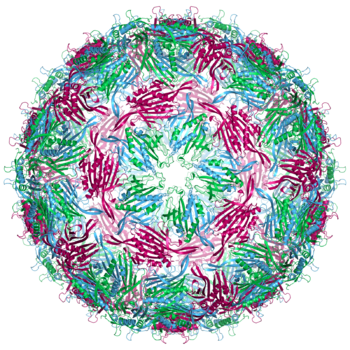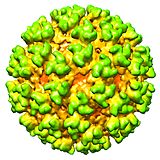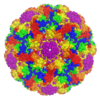Portal:Viruses
The Viruses Portal
Welcome!

Viruses are small infectious agents that can replicate only inside the living cells of an organism. Viruses infect all forms of life, including animals, plants, fungi, bacteria and archaea. They are found in almost every ecosystem on Earth and are the most abundant type of biological entity, with millions of different types, although only about 6,000 viruses have been described in detail. Some viruses cause disease in humans, and others are responsible for economically important diseases of livestock and crops.
Virus particles (known as virions) consist of genetic material, which can be either DNA or RNA, wrapped in a protein coat called the capsid; some viruses also have an outer lipid envelope. The capsid can take simple helical or icosahedral forms, or more complex structures. The average virus is about 1/100 the size of the average bacterium, and most are too small to be seen directly with an optical microscope.
The origins of viruses are unclear: some may have evolved from plasmids, others from bacteria. Viruses are sometimes considered to be a life form, because they carry genetic material, reproduce and evolve through natural selection. However they lack key characteristics (such as cell structure) that are generally considered necessary to count as life. Because they possess some but not all such qualities, viruses have been described as "organisms at the edge of life".
Selected disease
Hepatitis C is an infectious disease affecting mainly the liver, caused by hepatitis C virus (HCV), an RNA virus of the Flaviviridae family which only infects humans and chimpanzees. A "non-A non-B hepatitis" was postulated in the 1970s, and HCV was demonstrated in 1989. HCV is spread primarily by blood-to-blood contact associated with intravenous drug use in the developed world, and with improperly sterilised medical equipment and blood transfusions in the developing world. In about 80% of those infected, the virus establishes a chronic infection in the liver, and around 10–30% of those infected will develop cirrhosis over 30 years. Some people with cirrhosis go on to develop liver failure, liver cancer or other serious complications.
An estimated 143 million people worldwide (2%) have chronic HCV infections as of 2015. The prevalence is highest in Central and East Asia, North Africa and the Middle East. The virus causes around a quarter of cases of cirrhosis and hepatocellular carcinoma, and is a major reason for liver transplantation. The recommended therapy is an appropriate combination of protease inhibitors. Although 95% of people treated in this way are cured, the treatments are expensive and older therapies are less effective. No vaccine against hepatitis C is available.
Selected image
The MS2 bacteriophage was the first virus genome to be sequenced in 1976. Its capsid has an icosahedral structure made up from 180 copies of the coat protein.
Credit: Neil Ranson (7 June 2011)
In the news
26 February: In the ongoing pandemic of severe acute respiratory syndrome coronavirus 2 (SARS-CoV-2), more than 110 million confirmed cases, including 2.5 million deaths, have been documented globally since the outbreak began in December 2019. WHO
18 February: Seven asymptomatic cases of avian influenza A subtype H5N8, the first documented H5N8 cases in humans, are reported in Astrakhan Oblast, Russia, after more than 100,0000 hens died on a poultry farm in December. WHO
14 February: Seven cases of Ebola virus disease are reported in Gouécké, south-east Guinea. WHO
7 February: A case of Ebola virus disease is detected in North Kivu Province of the Democratic Republic of the Congo. WHO
4 February: An outbreak of Rift Valley fever is ongoing in Kenya, with 32 human cases, including 11 deaths, since the outbreak started in November. WHO
21 November: The US Food and Drug Administration (FDA) gives emergency-use authorisation to casirivimab/imdevimab, a combination monoclonal antibody (mAb) therapy for non-hospitalised people twelve years and over with mild-to-moderate COVID-19, after granting emergency-use authorisation to the single mAb bamlanivimab earlier in the month. FDA 1, 2
18 November: The outbreak of Ebola virus disease in Équateur Province, Democratic Republic of the Congo, which started in June, has been declared over; a total of 130 cases were recorded, with 55 deaths. UN
Selected article
A global drive to eradicate poliovirus started in 1988, when there were an estimated 350,000 cases of wild poliovirus infection globally. Two diseases, both caused by viruses, have been eradicated, smallpox in 1980 and rinderpest in 2011. Poliovirus only infects humans. It persists in the environment for a few weeks at room temperature and a few months at 0–8 °C. The oral polio vaccine is inexpensive, highly effective and is predicted to generate lifelong immunity. Reversion of live vaccine strains to virulence has resulted in occasional cases of vaccine-associated polio paralysis.
Two of the three strains of wild-type poliovirus have been eradicated. Annual reported cases of wild poliovirus infection fell to a low of 22 in 2017, but had risen to 176 in 2019. As of 2020, the wild virus remains endemic only in Afghanistan and Pakistan, but vaccine-derived poliovirus is circulating in several countries. A lack of basic health infrastructure and civil war remain significant obstacles to eradication. Some local communities have opposed immunisation campaigns, and vaccination workers have been murdered in Pakistan and Nigeria.
Selected outbreak
The West African Ebola epidemic was the most widespread outbreak of the disease to date. Beginning in Meliandou in southern Guinea in December 2013, it spread to adjacent Liberia and Sierra Leone, affecting the cities of Conakry and Monrovia, with minor outbreaks in Mali and Nigeria. Cases reached a peak in October 2014 and the epidemic was under control by late 2015, although occasional cases continued to occur into April 2016. Ring vaccination with the then-experimental vaccine rVSV-ZEBOV was trialled in Guinea.
More than 28,000 suspected cases were reported with more than 11,000 deaths; the case fatality rate was around 40% overall and around 58% in hospitalised patients. Early in the epidemic nearly 10% of the dead were healthcare workers. The outbreak left about 17,000 survivors, many of whom reported long-lasting post-recovery symptoms. Extreme poverty, dysfunctional healthcare systems, distrust of government after years of armed conflict, local burial customs of washing the body, the unprecedented spread of Ebola to densely populated cities, and the delay in response of several months all contributed to the failure to control the epidemic.
Selected quotation
| “ | A virus is not an individual organism in the ordinary sense of the term, but something which could almost be called a stream of biological patterns. | ” |
Recommended articles
Viruses & Subviral agents: bat virome • elephant endotheliotropic herpesvirus • HIV • introduction to viruses![]() • Playa de Oro virus • poliovirus • prion • rotavirus
• Playa de Oro virus • poliovirus • prion • rotavirus![]() • virus
• virus![]()
Diseases: colony collapse disorder • common cold • croup • dengue fever![]() • gastroenteritis • Guillain–Barré syndrome • hepatitis B • hepatitis C • hepatitis E • herpes simplex • HIV/AIDS • influenza
• gastroenteritis • Guillain–Barré syndrome • hepatitis B • hepatitis C • hepatitis E • herpes simplex • HIV/AIDS • influenza![]() • meningitis
• meningitis![]() • myxomatosis • polio
• myxomatosis • polio![]() • pneumonia • shingles • smallpox
• pneumonia • shingles • smallpox
Epidemiology & Interventions: 2007 Bernard Matthews H5N1 outbreak • Coalition for Epidemic Preparedness Innovations • Disease X • 2009 flu pandemic • HIV/AIDS in Malawi • polio vaccine • Spanish flu • West African Ebola virus epidemic
Virus–Host interactions: antibody • host • immune system![]() • parasitism • RNA interference
• parasitism • RNA interference![]()
Methodology: metagenomics
Social & Media: And the Band Played On • Contagion • "Flu Season" • Frank's Cock![]() • Race Against Time: Searching for Hope in AIDS-Ravaged Africa
• Race Against Time: Searching for Hope in AIDS-Ravaged Africa![]() • social history of viruses
• social history of viruses![]() • "Steve Burdick" • "The Time Is Now" • "What Lies Below"
• "Steve Burdick" • "The Time Is Now" • "What Lies Below"
People: Brownie Mary • Macfarlane Burnet![]() • Bobbi Campbell • Aniru Conteh • people with hepatitis C
• Bobbi Campbell • Aniru Conteh • people with hepatitis C![]() • HIV-positive people
• HIV-positive people![]() • Bette Korber • Henrietta Lacks • Linda Laubenstein • Barbara McClintock
• Bette Korber • Henrietta Lacks • Linda Laubenstein • Barbara McClintock![]() • poliomyelitis survivors
• poliomyelitis survivors![]() • Joseph Sonnabend • Eli Todd • Ryan White
• Joseph Sonnabend • Eli Todd • Ryan White![]()
Selected virus
Alphaviruses are a genus of RNA viruses in the Togaviridae family. The spherical enveloped virion is 70 nm in diameter, with a nucleocapsid of 40 nm. It has a single-stranded, positive-sense RNA genome of 11–12 kb. The genus contains more than thirty species, which infect humans, horses, rodents and other mammals, as well as fish, birds, other vertebrates and invertebrates. Alphaviruses are generally transmitted by insect vectors, predominantly mosquitoes, and are an example of arboviruses (arthropod-borne viruses).
The first alphavirus to be discovered was western equine encephalitis virus, by Karl Friedrich Meyer in 1930, in horses with fatal encephalitis in San Joaquin Valley, California, USA. Some members of the genus cause significant disease in humans, including the chikungunya, o'nyong'nyong, Ross River, Sindbis, Barmah Forest and Semliki Forest (pictured) viruses and the eastern, western and Venezuelan equine encephalitis viruses. Arthritis, encephalitis, rashes and fever are the most frequently observed symptoms. Large mammals such as humans usually form dead-end hosts for the viruses, although Venezuelan equine encephalitis virus is mainly amplified in the horse. No human vaccine or antiviral drug has been licensed. Prevention is predominantly by control of the insect vector.
Did you know?
- ...that murine polyomavirus (pictured) is an oncovirus that causes tumours in newborn mice?
- ...that Pat Nuttall showed that systemic infection of the host is not required for pathogens such as tick-borne encephalitis virus to be transmitted between vectors?
- ...that the first person to die in Australia from the 2009 flu was a Pintupi man whose people gave up hunting to settle the remote community of Kiwirrkura at the time of his birth?
- ...that the 2011 film Asmaa is the first feature-length Egyptian drama film to present AIDS patients sympathetically?
- ...that the anti-vaccine book Melanie's Marvelous Measles has received over 1,000 one-star reviews on Amazon.com?
Selected biography
Ali Maow Maalin (1954 – 22 July 2013) was a hospital cook and health worker from Merca, Somalia, who is the last person in the world known to be infected with naturally occurring smallpox. Although he worked in the local smallpox eradication programme, he had not been successfully vaccinated. In October 1977, he was infected with the Variola minor strain of the virus while driving two children with smallpox symptoms to quarantine. He did not experience complications and made a full recovery. An aggressive containment campaign was successful in preventing an outbreak, and smallpox was declared to have been eradicated globally by the World Health Organization (WHO) two years later.
In later life, Maalin volunteered for the successful poliomyelitis eradication campaign in Somalia. He worked for WHO as a local coordinator with responsibility for social mobilisation, and spent several years travelling across Somalia, vaccinating children and educating communities. He encouraged people to be vaccinated by sharing his experiences with smallpox. He died of malaria while carrying out polio vaccinations after the reintroduction of poliovirus to the country in 2013.
In this month
May 1955: First issue of Virology; first English-language journal dedicated to virology
4 May 1984: HTLV-III, later HIV, identified as the cause of AIDS by Robert Gallo and coworkers
5 May 1939: First electron micrographs of tobacco mosaic virus taken by Helmut Ruska and coworkers
5 May 1983: Structure of influenza neuraminidase solved by Jose Varghese, Graeme Laver and Peter Colman
8 May 1980: WHO announced formally the global eradication of smallpox
11 May 1978: SV40 sequenced by Walter Fiers and coworkers
12 May 1972: Gene for bacteriophage MS2 coat protein is sequenced by Walter Fiers and coworkers, the first gene to be completely sequenced
13 May 2011: Boceprevir approved for the treatment of chronic hepatitis C virus (HCV) infection, the first direct-acting antiviral for HCV
14 May 1796: Edward Jenner inoculated James Phipps (pictured) with cowpox
15/16 May 1969: Death of Robert Rayford, the earliest confirmed case of AIDS outside Africa
18 May 1998: First World AIDS Vaccine Day
20 May 1983: Isolation of the retrovirus LAV, later HIV, by Luc Montagnier, Françoise Barré-Sinoussi and coworkers
23 May 2011: Telaprevir approved for the treatment of chronic HCV infection
25 May 2011: WHO declared rinderpest eradicated
31 May 1937: First results in humans from the 17D vaccine for yellow fever published by Max Theiler and Hugh H. Smith
Selected intervention
Nevirapine (also Viramune) is an antiretroviral drug used in the treatment of HIV/AIDS caused by HIV-1. It was the first non-nucleoside reverse transcriptase inhibitor to be licensed, which occurred in 1996. Like nucleoside inhibitors, nevirapine inhibits HIV's reverse transcriptase enzyme, which copies the viral RNA into DNA and is essential for its replication. Unlike nucleoside inhibitors, it binds not in the enzyme's active site but in a nearby hydrophobic pocket, causing a conformational change in the enzyme that prevents it from functioning. Mutations in the pocket generate resistance to nevirapine, which develops rapidly unless viral replication is completely suppressed. The drug is therefore only used together with other anti-HIV drugs in combination therapy. The HIV-2 reverse transcriptase has a different pocket structure, rendering it inherently resistant to nevirapine and other first-generation NNRTIs. A single dose of nevirapine is a cost-effective way to reduce mother-to-child transmission of HIV, and has been recommended by the World Health Organization for use in resource-poor settings. Other protocols are recommended in the United States. Rash is the most common adverse event associated with the drug.
Subcategories
Subcategories of virology:
Topics
Things to do
- Comment on what you like and dislike about this portal
- Join the Viruses WikiProject
- Tag articles on viruses and virology with the project banner by adding {{WikiProject Viruses}} to the talk page
- Assess unassessed articles against the project standards
- Create requested pages: red-linked viruses | red-linked virus genera
- Expand a virus stub into a full article, adding images, citations, references and taxoboxes, following the project guidelines
- Create a new article (or expand an old one 5-fold) and nominate it for the main page Did You Know? section
- Improve a B-class article and nominate it for Good Article
 or Featured Article
or Featured Article status
status - Suggest articles, pictures, interesting facts, events and news to be featured here on the portal
WikiProjects & Portals
 WikiProject Viruses
Related WikiProjects
WikiProject Viruses
Related WikiProjects
Medicine • Microbiology • Molecular & Cellular Biology • Veterinary Medicine
Related PortalsAssociated Wikimedia
The following Wikimedia Foundation sister projects provide more on this subject:
-
Commons
Free media repository -
Wikibooks
Free textbooks and manuals -
Wikidata
Free knowledge base -
Wikinews
Free-content news -
Wikiquote
Collection of quotations -
Wikisource
Free-content library -
Wikispecies
Directory of species -
Wikiversity
Free learning tools -
Wiktionary
Dictionary and thesaurus



















